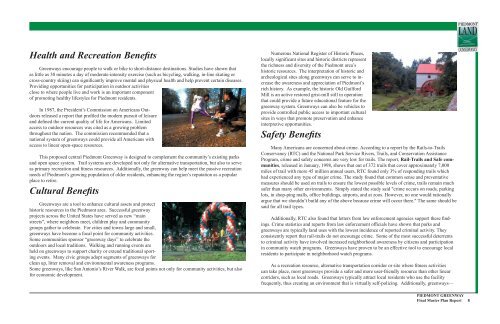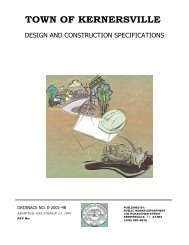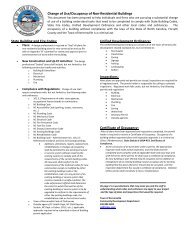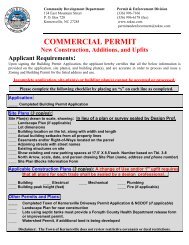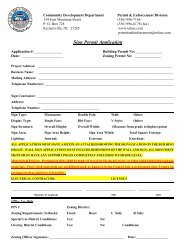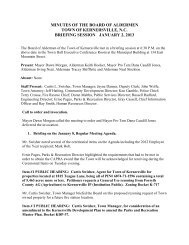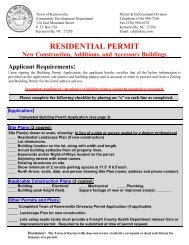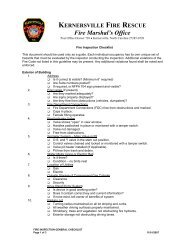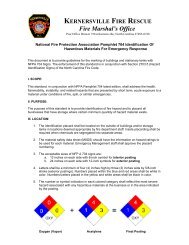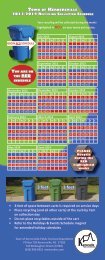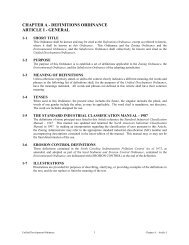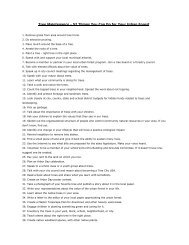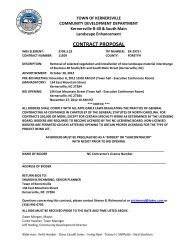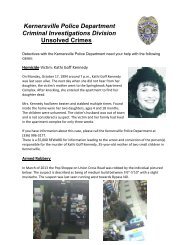Piedmont Greenway Master Plan - Town of Kernersville
Piedmont Greenway Master Plan - Town of Kernersville
Piedmont Greenway Master Plan - Town of Kernersville
- No tags were found...
You also want an ePaper? Increase the reach of your titles
YUMPU automatically turns print PDFs into web optimized ePapers that Google loves.
Health and Recreation Benefits<br />
<strong>Greenway</strong>s encourage people to walk or bike to short-distance destinations. Studies have shown that<br />
as little as 30 minutes a day <strong>of</strong> moderate-intensity exercise (such as bicycling, walking, in-line skating or<br />
cross-country skiing) can significantly improve mental and physical health and help prevent certain diseases.<br />
Providing opportunities for participation in outdoor activities<br />
close to where people live and work is an important component<br />
<strong>of</strong> promoting healthy lifestyles for <strong>Piedmont</strong> residents.<br />
In 1987, the President’s Commission on Americans Outdoors<br />
released a report that pr<strong>of</strong>iled the modern pursuit <strong>of</strong> leisure<br />
and defined the current quality <strong>of</strong> life for Americans. Limited<br />
access to outdoor resources was cited as a growing problem<br />
throughout the nation. The commission recommended that a<br />
national system <strong>of</strong> greenways could provide all Americans with<br />
access to linear open-space resources.<br />
This proposed central <strong>Piedmont</strong> <strong>Greenway</strong> is designed to complement the community’s existing parks<br />
and open space system. Trail systems are developed not only for alternative transportation, but also to serve<br />
as primary recreation and fitness resources. Additionally, the greenway can help meet the passive recreation<br />
needs <strong>of</strong> <strong>Piedmont</strong>’s growing population <strong>of</strong> older residents, enhancing the region’s reputation as a popular<br />
place to retire.<br />
Cultural Benefits<br />
<strong>Greenway</strong>s are a tool to enhance cultural assets and protect<br />
historic resources in the <strong>Piedmont</strong> area. Successful greenway<br />
projects across the United States have served as new “main<br />
streets”, where neighbors meet, children play and community<br />
groups gather to celebrate. For cities and towns large and small,<br />
greenways have become a focal point for community activities.<br />
Some communities sponsor “greenway days” to celebrate the<br />
outdoors and local traditions. Walking and running events are<br />
held on greenways to support charity or extend traditional sporting<br />
events. Many civic groups adopt segments <strong>of</strong> greenways for<br />
clean up, litter removal and environmental awareness programs.<br />
Some greenways, like San Antonio’s River Walk, are focal points not only for community activities, but also<br />
for economic development.<br />
Numerous National Register <strong>of</strong> Historic Places,<br />
locally significant sites and historic districts represent<br />
the richness and diversity <strong>of</strong> the <strong>Piedmont</strong> area’s<br />
historic resources. The interpretation <strong>of</strong> historic and<br />
archeological sites along greenways can serve to increase<br />
the awareness and appreciation <strong>of</strong> <strong>Piedmont</strong>’s<br />
rich history. As example, the historic Old Guilford<br />
Mill is an active restored grist-mill still in operation<br />
that could provide a future educational feature for the<br />
greenway system. <strong>Greenway</strong>s can also be vehicles to<br />
provide controlled public access to important cultural<br />
sites in ways that promote preservation and enhance<br />
interpretive opportunities.<br />
Safety Benefits<br />
Many Americans are concerned about crime. According to a report by the Rails-to-Trails<br />
Conservancy (RTC) and the National Park Service Rivers, Trails, and Conservation Assistance<br />
Program, crime and safety concerns are very low for trails. The report, Rail-Trails and Safe communities,<br />
released in January, 1998, shows that out <strong>of</strong> 372 trails that cover approximately 7,000<br />
miles <strong>of</strong> trail with more 45 million annual users, RTC found only 3% <strong>of</strong> responding trails which<br />
had experienced any type <strong>of</strong> major crime. The study found that common sense and preventative<br />
measures should be used on trails to ensure the lowest possible levels <strong>of</strong> crime, trails remain much<br />
safer than many other environments. Simply stated the study said "crime occurs on roads, parking<br />
lots, in shop-ping malls, <strong>of</strong>fice buildings, airports, and at zoos. However, no one would rationally<br />
argue that we shouldn’t build any <strong>of</strong> the above because crime will occur there." The same should be<br />
said for all trail types.<br />
Additionally, RTC also found that letters from law enforcement agencies support these findings.<br />
Crime statistics and reports from law enforcement <strong>of</strong>ficials have shown that parks and<br />
greenways are typically land uses with the lowest incidence <strong>of</strong> reported criminal activity. They<br />
consistently report that rail-trails do not encourage crime. Some <strong>of</strong> the most successful deterrents<br />
to criminal activity have involved increased neighborhood awareness by citizens and participation<br />
in community watch programs. <strong>Greenway</strong>s have proven to be an effective tool to encourage local<br />
residents to participate in neighborhood watch programs.<br />
As a recreation resource, alternative transportation corridor or site where fitness activities<br />
can take place, most greenways provide a safer and more user-friendly resource than other linear<br />
corridors, such as local roads. <strong>Greenway</strong>s typically attract local residents who use the facility<br />
frequently, thus creating an environment that is virtually self-policing. Additionally, greenways—<br />
PIEDMONT GREENWAY<br />
Final <strong>Master</strong> <strong>Plan</strong> Report 8


